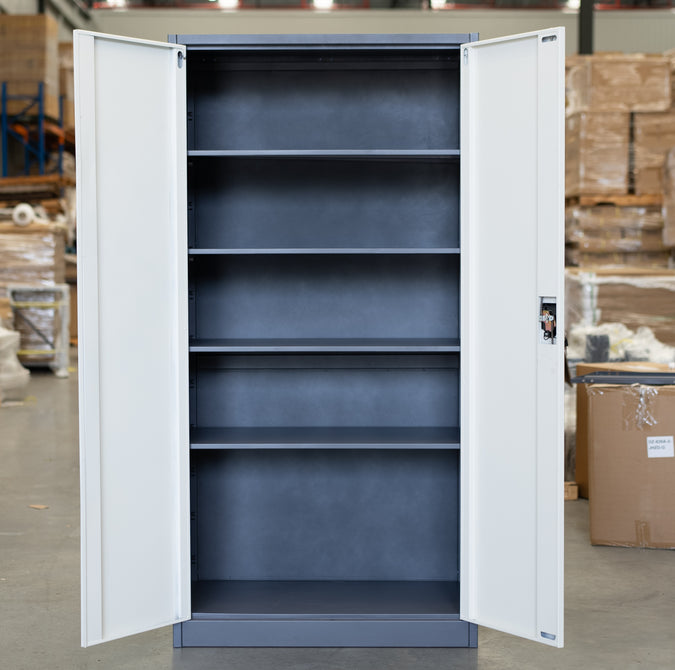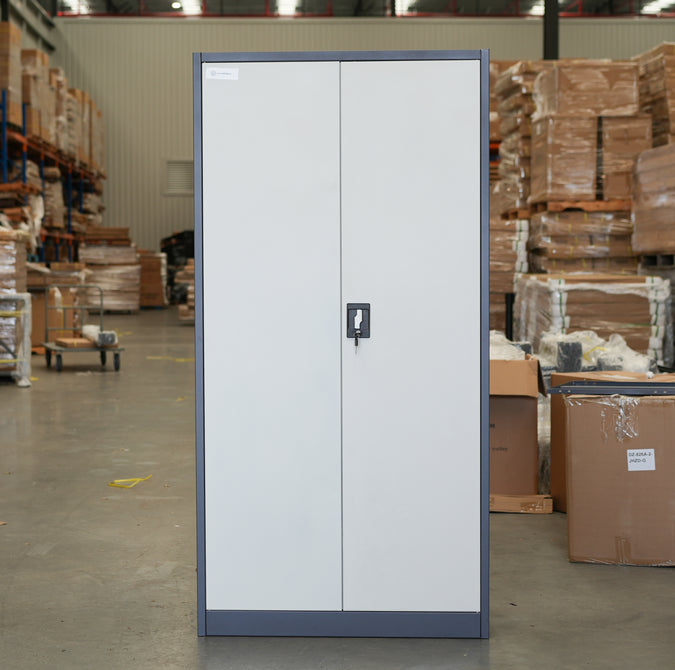When it comes to keeping your home, office, or workspace organized, storage cabinets play a vital role. From compact file cabinets to heavy-duty garage shelving, each type of cabinet is designed to serve a specific purpose. In this article, we’ll explore the main types of storage cabinets, their materials, and best uses — plus a spotlight on the Steel Power Shelving File Cabinet Grey & White Storage Unit, a top-performing choice for professionals seeking functionality and durability.

Table of Contents
- Overview of Storage Cabinets
- Main Types of Storage Cabinets
- Common Materials Used in Storage Cabinets
- Essential Features to Consider
- Spotlight: Steel Power Shelving File Cabinet Grey & White Storage Unit
- Best Applications for Storage Cabinets
- Summary Table: Comparing Storage Cabinet Types
- FAQs About Storage Cabinets
- References
Overview of Storage Cabinets
Storage cabinets are essential for maintaining order in both residential and commercial environments. They come in various designs — from wall-mounted options that save floor space to freestanding cabinets designed for high-capacity storage. Whether you’re organizing office documents, workshop tools, or household supplies, the right cabinet can help improve accessibility, security, and aesthetics.
The best storage cabinet depends on your needs: some prioritize security and durability, while others emphasize style and space efficiency. Modern innovations such as modular, adjustable, and lockable cabinets have expanded the range of choices for homeowners and businesses alike.
Main Types of Storage Cabinets
1. File Cabinets

File cabinets are designed to store and organize documents, files, and folders in an orderly way. They’re most common in offices, schools, and home workspaces.
- Vertical File Cabinets: Narrow and tall, perfect for small offices with limited space.
- Lateral File Cabinets: Wider units that hold larger volumes of documents and allow for easy access.
- Mobile File Cabinets: Compact units on casters that can be moved easily under desks.
2. Metal Storage Cabinets

Metal cabinets are known for their strength, longevity, and industrial-grade performance. They are ideal for garages, workshops, and commercial storage areas.
- Steel Cabinets: Resistant to dents and corrosion — suitable for tool or equipment storage.
- Powder-Coated Cabinets: Add visual appeal and protect against rust.
- Lockable Metal Cabinets: Offer secure storage for sensitive or valuable items.
3. Wooden Storage Cabinets

Wooden cabinets are favored for their classic look and home-friendly appeal. They’re commonly used in living rooms, kitchens, and offices.
- Solid Wood Cabinets: Offer natural beauty and durability.
- Engineered Wood (MDF or Particleboard): Cost-effective and stylish options.
- Decorative Finishes: Veneer or laminate finishes enhance resistance to scratches and moisture.
4. Plastic Storage Cabinets

Lightweight and resistant to moisture, plastic cabinets are perfect for outdoor areas, basements, and utility rooms.
- Weather-resistant and easy to clean.
- Ideal for temporary or light-duty storage.
- Affordable and low-maintenance solution.
5. Modular and Adjustable Cabinets
Modular storage systems allow users to customize configurations based on space and function. They are popular in garages, workshops, and offices that evolve over time.
- Interchangeable shelving units and drawers.
- Expandable systems for growing storage needs.
- Modern, minimalist designs for flexible spaces.
Common Materials Used in Storage Cabinets
The choice of material greatly influences the durability, appearance, and maintenance of your cabinet. Below are the most popular options:
- Steel: Long-lasting, sturdy, and ideal for industrial use.
- Aluminum: Lightweight yet corrosion-resistant.
- Wood: Aesthetic appeal with warmth, but requires regular care.
- Plastic/Resin: Budget-friendly, suitable for moisture-prone areas.
- Glass and Metal Combinations: Stylish for offices and showrooms.
Essential Features to Consider
1. Size and Capacity
Determine the volume of items you plan to store. Cabinets range from small desktop units to tall freestanding models exceeding 1.8 meters in height.
2. Adjustability
Adjustable shelving offers flexibility for different item heights, making it ideal for offices and multipurpose rooms.
3. Locking Mechanism
For sensitive files or valuable tools, opt for cabinets with secure locking systems to ensure privacy and protection.
4. Material Strength and Finish
Powder-coated finishes and thick-gauge metal improve longevity, scratch resistance, and rust prevention.
5. Assembly and Maintenance
Look for click-in systems or pre-drilled holes for easy assembly. Low-maintenance surfaces simplify cleaning and upkeep.
Spotlight: Steel Power Shelving File Cabinet Grey & White Storage Unit

The Steel Power Shelving File Cabinet Grey & White Storage Unit is a premium-quality storage solution engineered for efficiency and durability. It’s perfect for both office environments and industrial storage spaces.
Specifications:
- Dimensions: 1.80m (Height) x 0.9m (Length) x 0.5m (Depth)
- Color: Elegant Grey & White finish
- Weight: 65kg
- Warranty: 1 Year
Key Features:
- Adjustable Layer Height: Flexible shelving for different file sizes and objects.
- Premium Powder-Coated Finish: Provides corrosion resistance and a sleek modern appearance.
- Easy Assembly: Includes a super easy click-in system that requires no special tools.
- Durable Steel Construction: Supports heavy loads and withstands daily use.
Why Choose Steel Power Shelving?
This unit stands out as a combination of industrial durability and modern aesthetics. It’s designed for spaces that demand both functionality and style — from corporate offices to personal workshops. The flexible layer height means you can customize your storage layout at any time, accommodating everything from large binders to small tools.
Ideal Uses:
- Office filing and document storage
- Garage tool organization
- Warehouse inventory management
- Home or studio equipment storage
Best Applications for Storage Cabinets
Different environments call for different cabinet types. Here’s how to match the right storage system to your space:
- Office: File cabinets and metal storage units for documents and supplies.
- Garage: Heavy-duty steel cabinets and adjustable racks for tools.
- Kitchen: Wooden or laminate cabinets for dishware and dry goods.
- Workshop: Modular steel shelving and lockable cabinets for safety.
- Outdoor Areas: Weather-resistant plastic or stainless steel cabinets.
Summary Table: Comparing Storage Cabinet Types
| Cabinet Type | Material | Best For | Key Benefit |
|---|---|---|---|
| File Cabinet | Metal or Wood | Office, Home | Organized document storage |
| Metal Storage Cabinet | Steel or Aluminum | Garage, Workshop | High strength and durability |
| Wooden Cabinet | Solid Wood or MDF | Living Spaces, Offices | Classic aesthetics |
| Plastic Cabinet | Resin or Polymer | Outdoor, Utility Areas | Lightweight and moisture-proof |
| Steel Power Shelving Unit | Powder-Coated Steel | Office, Garage | Adjustable, durable, easy assembly |
FAQs About Storage Cabinets
1. What is the best material for long-lasting storage cabinets?
Steel and powder-coated metal are the most durable materials, ideal for heavy-duty and industrial applications.
2. Can I adjust the shelves in a Steel Power Shelving cabinet?
Yes, the Steel Power Shelving File Cabinet offers adjustable layer height, allowing flexibility for different storage needs.
3. Are metal cabinets suitable for home use?
Absolutely! Modern designs feature sleek finishes like grey and white tones, making them stylish enough for home offices or living areas.
4. Do storage cabinets require assembly?
Most units come with a click-in or screw system for quick assembly. The Steel Power Shelving unit, for example, can be set up easily without professional tools.
5. How can I maintain my metal storage cabinet?
Wipe regularly with a damp cloth, avoid harsh chemicals, and ensure good ventilation to prevent moisture buildup.

